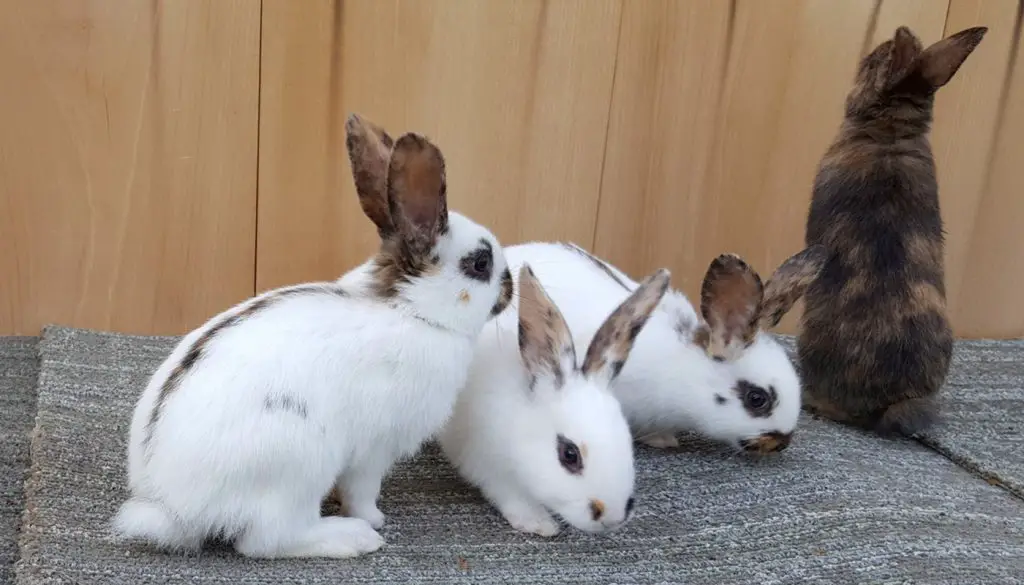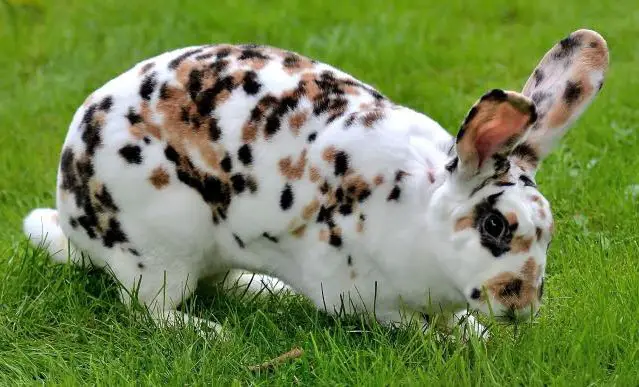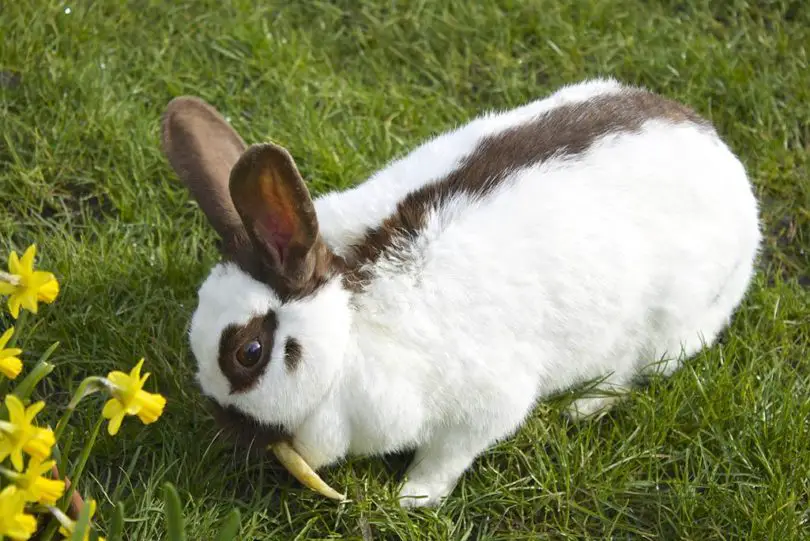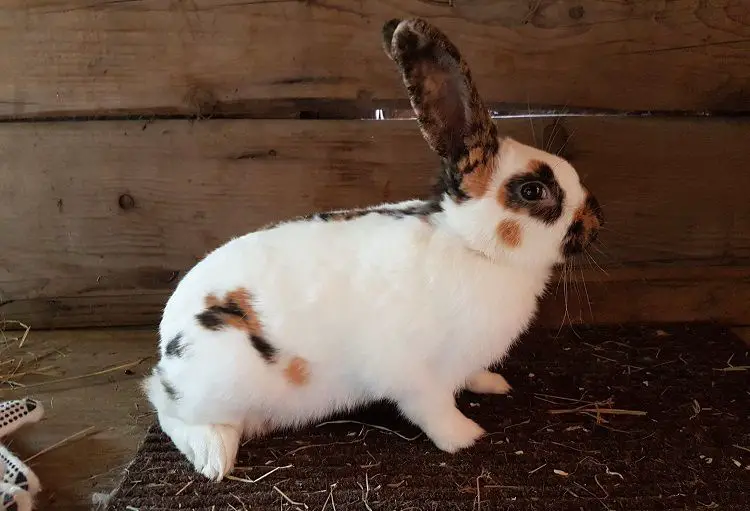Last Updated on June 12, 2023 by Laura Thompson
Contents
- 1 What is a Rhinelander Rabbit?
- 2 The Origin and History Of The Rhineland Bunnies
- 3 The appearance and colors of Rhinelander Rabbits
- 4 Specific Characteristics of Rhinelander Rabbits
- 5 Size of Rhinelander Rabbits
- 6 The lifespan of Rhinelander Rabbits
- 7 The personality of Rhinelander Rabbits
- 8 Behavior and temperament of Rhinelander Rabbits
- 9 Rhinelander Rabbits as pets
- 10 Caring for Your Rhinelander Rabbit
- 11 Health and Hygiene of Rhinelander Rabbits
- 12 Do Rhinelander Rabbits need cages?
- 13 Conclusion
What is a Rhinelander Rabbit?

Rhinelander Rabbits are among the most popular bunny breeds in the United States.
This breed of rabbits originated in the late 1800s, and they are one of seven recognized breeds by the American Rabbit Breeders Association.
They’re well-known for their white fur and black markings, as well as being one of the largest rabbit breeds.
They’re also known as “Rhinies”.
This article will provide you with everything you need to know about Rhinelander Bunnies, from where they originated to how they behave around humans.
The Origin and History Of The Rhineland Bunnies
The Rhineland Bunnies have been around since the 18th century and originated in Germany. The rabbits were originally bred to be raised for their fur, meat, and hide.
There is not much information about how they got their name, but some speculate that it might come from the Rhine River Valley where these animals originate from
They are also thought to have been first exported through Cologne on its way to other areas of Europe like Belgium and France which rhymes with “Rhineland.”
The appearance and colors of Rhinelander Rabbits

Rhinelander Rabbits have long, dense fur with white markings that they inherit from their parents.
The colors of the Rhinelander Rabbit can vary and are determined by the genes of its parent as well as environmental factors.
Some examples include:
- Blue silver lop
- Chocolate brown
- Champagne beige
- Black-spotted buckskin buck (a type of albino)
- Tortoiseshell cream bunny with a pink nose and eye rims
- Snowshoe rabbit which has light ginger to orange stripes on its legs for camouflage in winter months.
Specific Characteristics of Rhinelander Rabbits
Rhinelander Rabbits are known for their distinctive markings, including a combination of black and white fur.
They are quite an attractive animal as well because they have long ears that often curl at the tips in addition to large eyes with dark pupils.
Rhinelander Rabbits also come from New Zealand originally, which is why this breed can be seen in many different colors such as blue or red.
Rhinelander Rabbits can grow up to 14 inches tall when fully grown and weigh around six pounds on average. This makes them one of the largest breeds out there- next only to Flemish Giants!
Size of Rhinelander Rabbits

The Rhinelander rabbit is a large breed of a bunny with an average size weighing about four to six pounds.
They are an old variety, bred in 1903 and named after their original breeder who lived near Rhinelander, Wisconsin.
Four-pound bunnies have been known to grow up to five or more pounds as adults.
Six-pound bunnies may range from seven to eight pounds as adults.
The lifespan of Rhinelander Rabbits
Rhinelander Rabbits are typically much larger than other rabbit breeds.
Their average lifespan is between five and eight years, which is usual for a house pet bunny.
There have been cases of these bunnies living up to 11 or 12 years old in captivity with the appropriate care.
The personality of Rhinelander Rabbits
Rhinelander Rabbits are active and intelligent rabbits.
They thrive on attention but can be sensitive to sudden changes in their surroundings.
Rhinelanders are rather vocal rabbits that will spend time talking back to you.
When it comes to interaction with humans, these rabbits do very well as long as they have had plenty of experience before or if the human is patient enough when handling them for the first few times.
These bunnies will enjoy having things placed in their cage such as cardboard boxes so they can dig through them and make themselves comfortable.
One thing worth noting is Rhinelander’s intelligence level isn’t just limited to how aggressive he/she may be towards other animals. (ie: dogs)
Behavior and temperament of Rhinelander Rabbits

Rhinelander Rabbits are very docile and friendly.
They will lick you if they like you, but when startled or frightened their first instinct is to take off running until reassured with a pat on the head.
Rhinelanders can be shy around strangers at first, so it’s recommended to introduce them slowly and gently.
Rhinelander Rabbits as pets
Rhinelaners make good friends because they are calm-natured and friendly.
At the same time, they are not too hyperactive and love to be held.
Rhinelander Rabbits can also be easily trained, which makes them perfect for beginners or children.
Rhinelanders were developed as a meat breed in the early 1900s, but they became popular pets after World War II because their calm demeanor was an ideal trait during wartime turmoil.
The popularity of these bunnies continues today with many different breeds available through pet stores and online marketplaces like Amazon.
Rhinelander Bunnies are often considered good pets for children and adults because they are interactive, non-aggressive, and have relatively low maintenance.
Caring for Your Rhinelander Rabbit
While Rhinelander Rabbits are generally easy to care for, they do have a few specific needs.
The tips below will help you provide your pet with the best possible living environment:
- Provide plenty of hay and fresh vegetables daily.
- Keep their cage clean by changing bedding regularly and wiping out food dishes every day.
- Give them cedar shavings in addition to straw as these smells are less overwhelming than pine or other aromas that may bother sensitive eyes or noses.
Health and Hygiene of Rhinelander Rabbits

Rhinelander Rabbits come with some specific needs that must be met to ensure their safety and wellbeing so here’s what you need to know about this lovely animal!
Many people fall victim to illness because they don’t keep up on routine hygiene for their pet rabbits.
Make sure they have an ample supply of hay at all times, especially if there is limited access to the grass outside.
Bunny litter is a must for their burrows and should be changed out at least once every three weeks.
Regularly clean up after them when they’re soiling themselves in the process of eating or playing.
The ears, eyes, nose, teeth, genitals, and bottom need to be checked for any signs of infection regularly.
If you see anything abnormal then it’s time to consult with your vet as soon as possible!
You may also want to consider clipping their nails before long-term neglect can cause injury and pain.
Do Rhinelander Rabbits need cages?
Rhinelander Rabbits are considered a social breed and do not need to be kept in cages.
Rhinelander bunnies can live comfortably with other rabbits as long as they have the same space needs.
One male may seem like enough, but females should only be housed together if there is more than one breeding female or all of them will fight over territory.
It’s best for Rhinelanders to keep their cage clean by removing droppings once a day.
Conclusion
Rhinelanders are one of the best pets in the world. They’re intelligent, loyal, and affectionate.
You probably don’t know much about them but you need to learn more because they might be your next pet!
Stop by our website today for some more facts about Rhinelan that will make you fall in love with them even more than ever before.
Laura is an experienced wildlife rehabilitator and conservationist residing in Madison, Wisconsin. Her love for rabbits was sparked during her early career when she nursed an injured wild rabbit back to health. Today, she runs “Hoppy Haven”, a rehabilitation center dedicated to the care and release of injured wild rabbits.
